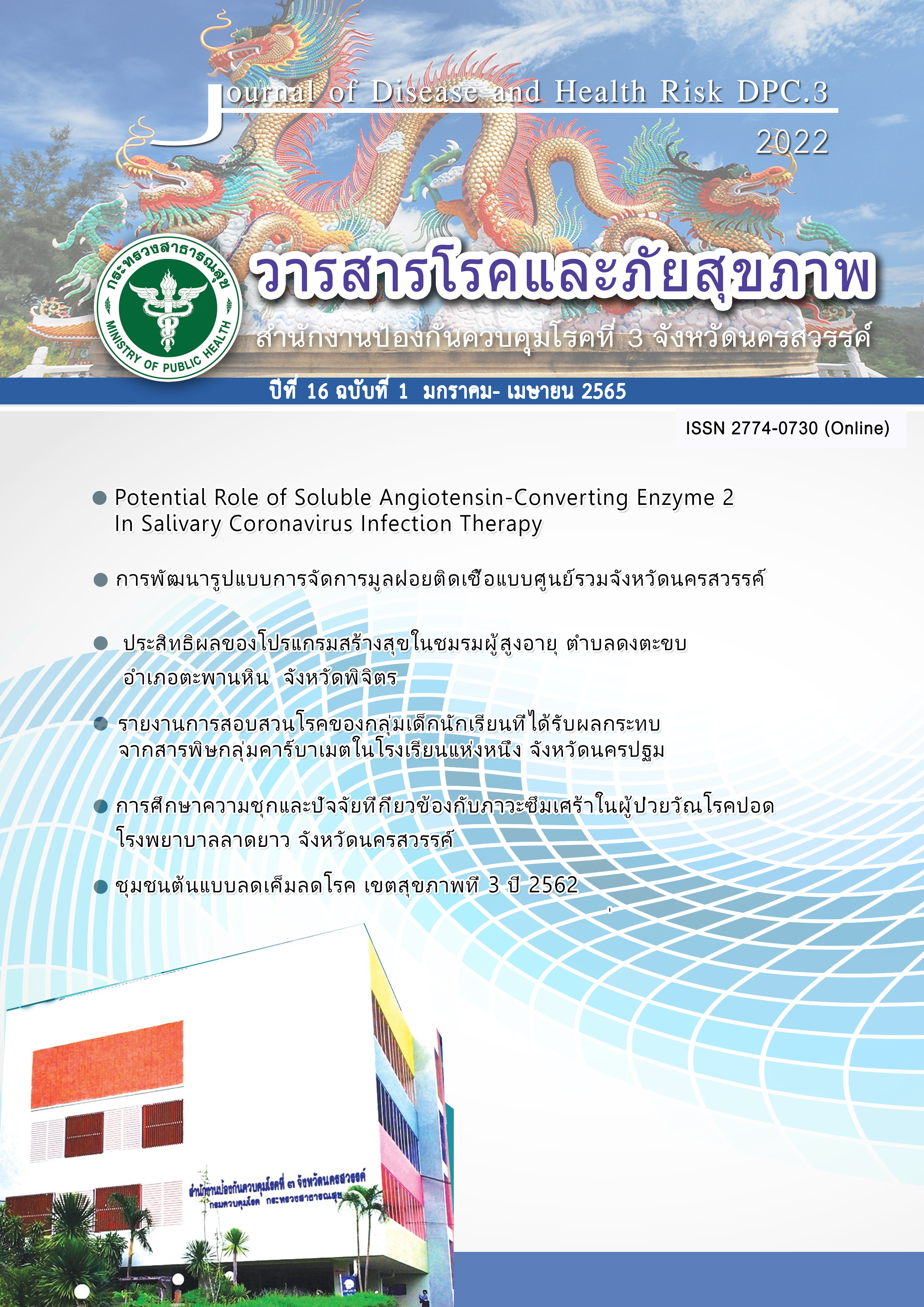The Effectiveness of Program Happiness in Elderly: A case Study of Elderly in Dongtakop Sub-district, Taphanhin District, Phichit Province
Keywords:
The Program for creating happiness, 5 dimensions of happiness, Elderly mental healthAbstract
The purpose of this Quasi-experimental research, one group pretest-posttest design for collecting elder’s information. To examine the Effectiveness of Program Happiness in Elderly in Dongtakop Sub-district, Taphanhin District, Phichit Province. The sample was selected from the elder who was 60 years older by selecting purposive sampling for 30 older persons. Data were collected between August 2020 and January 2021. There would have the activities along 6 months, 1 time per month for 3 hours by emphasis on 5 dimensions of happiness development. There are dimension of health, dimension of recreation, dimension of integrity, dimension of cognition and dimension peacefulness. Data collection was performed by using personal information questionnaire, health-related quality of life and happinometer. Compile qualitative information by using the elderly club learning recode form, the structural interview form, the focus group, the in-depth interview. The quantitative data was analyzed by using descriptive statistics to compare the mean score before and after the experiment using the Paired t-test statistics. The qualitative information was used content analysis,
The results indicated that after attended this program made their physical health quality of life increased from low to high level, mental health increased from low to high level, relationship increased from low to high level, environment increased from middle to high level, quality of life increased from low to high level, The average score of quality of life before and after joining the happiness program was found to be significantly higher (p – value< 0.5) in all aspects and overall, the level of happiness increased from a lower level of a general person to a higher level than an average person. The standard score of happiness after joining the program was significantly increased (p – value< 0.5).
References
ชมพูนุท พรหมภักดิ์. การเข้าสู่สังคมผู้สูงอายุของประเทศไทย บทความวิชาการ สำนักวิชาการ สำนักงานเลขาธิการวุฒิสภา. 2556; 3 (16): 1-19.
สุดารัตน์ นามกระจ่าง, ลักษณี สมรัตน, อนัญญา เดชะคำภู. ประสิทธิผลของโปรแกรมพัฒนาความสุข 5 มิติในผู้สูงอายุ กรณีศึกษาในผู้สูงอายุ ตำบลกระหวัน อำเภอขุนหาญ จังหวัดศรีสะเกษ. ในเอกสารการประชุมวิชาการเสนอผลงานวิจัย บัณฑิตศึกษา ระดับชาติและนานาชาติ 2560. มหาวิทยาลัยขอนแก่น, ขอนแก่น. 2556.
กรมสุขภาพจิต กระทรวงสาธารณสุข. การศึกษาประสิทธิผลโปรแกรมสร้างสุข 5 มิติ สำหรับผู้สูงอายุ. กรุงเทพฯ: สำนักส่งเสริมและพัฒนาสุขภาพจิต. 2560.
สำนักงานสาธารณสุขจังหวัดพิจิตร. สรุปผลงานประจำปีผู้สูงอายุสานักงาน สาธารณสุขจังหวัดพิจิตร ปี 2562. [เข้าถึงเมื่อ 1 มีนาคม 2563] เข้าถึงได้จาก http://www.ppho.go.th.
สำนักงานสาธารณสุขอำเภอตะพานหิน สำนักงานสารณสุขจังหวัดพิจิตร. สรุปผลงานประจำปีผู้สูงอายุ สำนักงานสารณสุขจังหวัดพิจิตร ปี 2562. [อินเตอร์เน็ต]. 2563. [เข้าถึงเมื่อ 1 มีนาคม 2563] เข้าถึงได้จาก http://www.ppho.go.th.
Kemmis, S & Mctargrat, R. The Action Research Planer (3rd ed.). Victoria: Deakin University. 1988.
อัมพร เบญจพลพิทักษ์, กาญจนา วณิชรมณีย์, พรรณี ภาณุวัฒน์สุข. “คู่มือความสุข 5 มิติสำหรับผู้สูงอายุ”. พิมพ์ครั้งที่ 2 กรุงเทพ: ชุมนุมสหกรณ์การเกษตรแห่งประเทศไทย; 2556.
พัชรี ถุงแก้ว. ผลของโปรแกรมส่งเสริมสุขภาพจิตด้วยรูปแบบความสุขเชิงจิตวิทยา 5 มิติเพื่อพัฒนาคุณภาพชีวิตและความสุขของผู้สูงอายุ. วารสารวิชาการและวิจัยสังคมศาสตร์. 2561;13(39) 41-54
เสาวนีย์ โสบุญ. รูปแบบการสร้างเสริมความรู้สึกมีคุณค่าในตนเองของผู้สูงอายุโดยการมีส่วนร่วมของชุมชน กรณีศึกษาพื้นที่เทศบาลตำบลตาดทอง อำเภอเมือง จังหวัดยโสธร. วารสารวิจัยสาธารณสุขศาสตร์ มหาวิทยาลัยราชภัฏอุบลราชธานี. 2560; 6(2): 43-54.
ทนงศักดิ์ มูลจันดา, ทัตภณ พละไชย. ผลการส่งเสริมสุขภาพของผู้สูงอายุด้วยสุข 5 มิติโรงเรียนผู้สูงอายุนาผาง ตำบลห้วย อำเภอปทุมราชวงศา จังหวัดอำนาจเจริญ. วารสารวิทยาศาสตร์สุขภาพวิทยาลัยพยาบาลบรมราชชนนี สรรพสิทธิประสงค์. 2561; 2(2): 14-29.
Lee, WT, Ko SI, Lee JK. Health promotion behaviors and quality of life among community–dwelling elderly in Korea: A cross-sectional survey. International Journal of Nursing Studies. 2006; 43: 293-300.
ชัชญาภา สมศรี, พิกุลทอง โมคมูล. ผลของกิจกรรมสร้างสุข 5 มิติ ต่อความสุขของผู้สูงอายุ ในคลินิกผู้สูงอายุ โรงพยาบาลนครพนม. วารสารโรงพยาบาลนครพนม. 2559;3(2):3-14.
Orem, D.E. Nursing concept of Practice 4thed. St Louis: Mosky Tear Book; 1991.
DupuyH J. The general well-being schedule. In F. McDowell & C. Newell (Eds.), A measuring health: A guide to ratingscales and questionnaires (p. 125). New York: Oxford University Press; 1977.
Dhramchareon W.Theeffects ofinternal andexternal factors on happiness inelderly. [thesis]. Bangkok: National Institute of Development Administration; 2012. (in Thai).
Wang J, Chen CY, Lai LJ, Chen ML, Chen MY. The effectiveness of a community-based health promotion program for rural elders: a quasi-experimental design. Appl Nurs Res. 2014;27(3):181-5.
โฆษิต กัลยา, หยกฟ้า เพ็งเลีย, สุขเสริม ทิพย์ปัญญา, ประสงค์ มีทุน, อัญชลี ถีปลี. ผลของโปรแกรมความสุข 5 มิติเชิงประยุกต์ในผู้สูงอายุ อำเภอท่าปลา จังหวัดอุตรดิตถ์เขตสุขภาพที่ 2. [อินเตอร์เน็ต]. 2561 [เข้าถึงเมื่อ 1 มีนาคม 2563] เข้าถึงได้จาก https://www.mhc2.go.th/newweb/files/docs/Research006.pdf
คนึง นันทะนะ. ทฤษฎีลำดับขั้นความต้องการ. [อินเตอร์เน็ต]. 2558 [เข้าถึงเมื่อ 1 มีนาคม 2563] เข้าถึงได้จาก http://www.thaischool.in.th/_files_school/62102138/data/62102138_1_20111209-131002.pdf
Downloads
Published
How to Cite
Issue
Section
License
Copyright (c) 2022 Journal of Disease and Health Risk DPC.3

This work is licensed under a Creative Commons Attribution-NonCommercial-NoDerivatives 4.0 International License.
Copyright notice
Article published in the Journal of Disease and Health Risk DPC.3 Nakhon Sawan. It is considered a work of academic research and analysis as well as the personal opinion of the author. It is not the opinion of the Office of Disease Prevention and Control 3, Nakhon Sawan. Or the editorial team in any way Authors are responsible for their articles.
Privacy Policy
Name, address and e-mail address specified in the Journal of Disease and Health Risk DPC.3 Nakhon Sawan. It is used for identification purposes of the journal. And will not be used for any other purpose. Or to another person.









